
Looting of Venice: paving, the "care" of the ancient "masegni"
Powered by |
Saccheggio di Venezia, la "cura" degli antichi masegni Looting of Venice: paving, the "care" of the ancient "masegni" |
| back |
| È così che si lavora? | Is this the way to do it? |
|---|---|
| Il prof. Cristinelli, docente presso l'Istituto di Architettura di Venezia, esperto convocato da Insula per la presentazione del secondo numero dei "Quaderni" presso la sede dell'Ateneo Veneto, ebbe a dire che i masegni sono parte importantissima per l'architettura veneziana, e che per la loro vetustà, bellezza e rarità andrebbero estratti "con le unghie". Come vediamo dalla prima foto, queste parole sono state interpretate nel senso delle unghie d'acciaio di una benna... La corretta tecnica di rimozione delle trachiti prevede che le pietre di ogni corso siano numerate e poi disposte in piedi corso per corso. Questo perché i masegni sono di misure irregolari, e solo una ricollocazione accurata può garantire un risultato ottimale, evitando di dover ricorrere a rattoppi e taglio di nuove pietre. In queste foto vediamo quale sia la cura che gli attuali operatori pongono in questo lavoro. | Professor Cristinelli, teacher at the Istituto di Architettura of Venice, was called by Insula (the consortium which manages most of the public works in Venice) as a restoration expert to introduce the second editionof their publication "Quaderni", held in Ateneo Veneto. He said that the "masegni" are a very important part of Venetian architecture. He also said that, as they are so ancient, beautiful and rare, we should use "the fingernails" to remove and reposition them. As we can see in the first photograph, his words have been interpreted as the steel "nails" of a mechanical grab... The correct method for the removal of trachyte paving has been established for some time; the stones of each course have to be numbered, and then stored vertically course by course. This method is required as the stones are irregular in size, and only very accurate repositioning can achieve a good result, and avoid the need to patch any spaces by cutting new stones as replacements. In these pictures we can see the kind of "care" the actual "restorers" took in managing and storing the stones. |
| Pescaria di Rialto (vedi sulla mappa): i grandi salizzoni, pietre fragili a causa della loro misura, vengono rimossi e accatastati con una pala meccanica. Certo, ogni pietra rotta prevede la vendita al Comune di una nuova (per queste misure si parla di oltre 1.500.000 lire ciascuna) e i pezzi di quella vecchia vanno ufficialmente in discarica. Il sospetto del Comitato per la Difesa di Venezia è che i cocci vadano invece alle taglierie, per diventare preziose piastrelle da arredamento. | 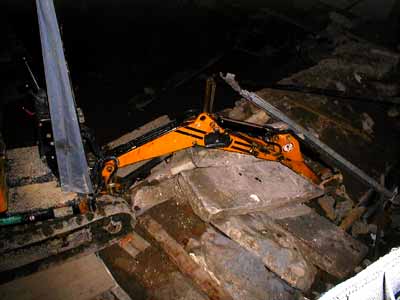 | Erbaria di Rialto (see ombra.net maps): the large "salizzoni" - extremely fragile stones due their size - are removed and stacked by the use of a mechanical grab. There is a deal with the Municipality whereby every broken stone is replaced by a brand new one - of this size many hundreds euros apiece - while the broken the "breakages" are "officially" taken to a dump. TheVenice Defence Committee suspects that these broken fragments may end up in stone-cutting factories, to be transformed into valuable tiles for interior decoration. |
| Pescaria di Rialto (vedi sulla mappa). Un esempio della cura con cui vengono accatastati i vecchi masegni. È evidente che non c’è alcuna intenzione di ricollocarli. Questo ormai è solo materiale grezzo, da avviare alle taglierie come fosse estratto da una cava. Poco conta se su queste pietre abbiano passeggiato Bellini e Tiziano, gli antichi Papi oppure Casanova... Oppure è proprio per questo che le vecchie pietre spariscono? | 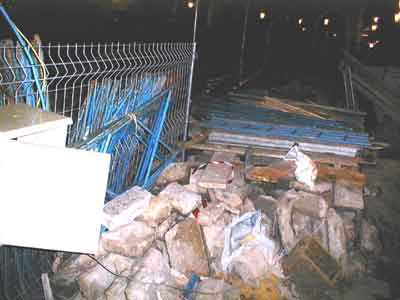 | Erbaria di Rialto: an example of how ancient "masegni" are stored. It is apparent that no interest has been shown in how they have been stored, or in what order. The result of this is that these stones are now fit only as rough material to be sent to the stone-cutters, as if they had just been supplied from a quarry. It does not seem to matter to the "managers" that on these same stones have been walked upon by Bellini and Tiziano, ancient Popes, Casanova... Or perhaps those historical connections are the reason that these ancient stones are disappearing? |
| Pescaria di Rialto (vedi sulla mappa). Un altro esempio dell’amore per Venezia e la sua storia, della competenza e onestà degli addetti ai lavori. | 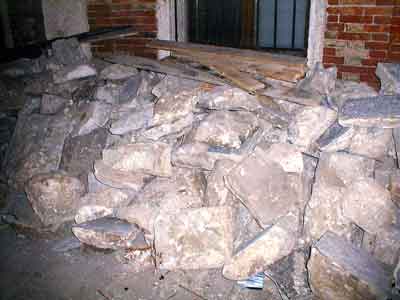 |
Erbaria di Rialto: another example of the love for Venice and its history, and yet another example of the level of competence and honesty of the people in charge of these works. |
| Fondamenta Bonlini a San Trovaso (vedi sulla mappa): qui i masegni sono usati come contenimento per materiale da discarica. E in discarica (Sacca san Mattio a Murano) sarebbero finiti a decine di migliaia i masegni scomparsi in città. Vien da pensare che a San Mattio ci sia ormai una specie di piramide di Cheope... | 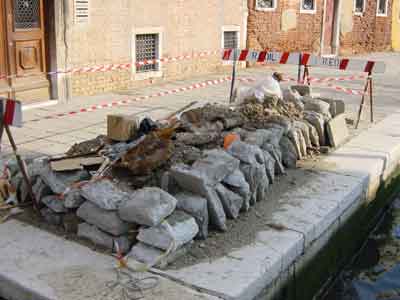 |
Fondamenta Bonlini at San Trovaso (see map): the masegni have been used to construct a retaining wall for a pile of material waiting to be taken away to a dump. Just one of these dumps, Sacca San Mattio on Murano, should now contain tens of thousands of "masegni" missing from Venice. One could almost think that in that small island something like an Egyptian pyramid is growing upwards... |
| Fondamenta Sant’Eufemia alla Giudecca (vedi sulla mappa): come vedremo anche nella sezione pietra d'Istria, non si ha riguardo per i materiali rimossi, che vengono accatastati come fossero breccia di cava. Nel caso di questa bitta in trachite, certo antica e scolpita a mano, non si è ritenuto di proteggerla, e il movimento della pesante benna che lavorava in questo cantiere (vedi Giudecca) la ha schiantata | 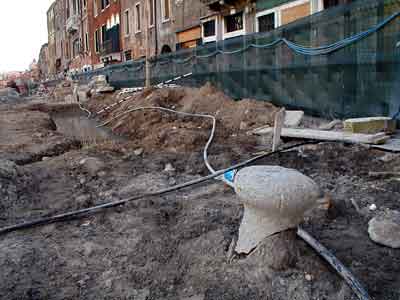 |
Fondamenta Sant'Eufemia in the Giudecca (see ombra.net maps): as will also be seen in the section on Istrian stone, no care has been shown for the materials that have been removed. They have been piled up like quarry breccia. In the case of this trachyte bollard, handcrafted and very old, nobody thought to protect it from the heavy machinery working in and moving around this building yard - see also Giudecca - causing it to split. |
foto e testo di Umberto Sartory
back